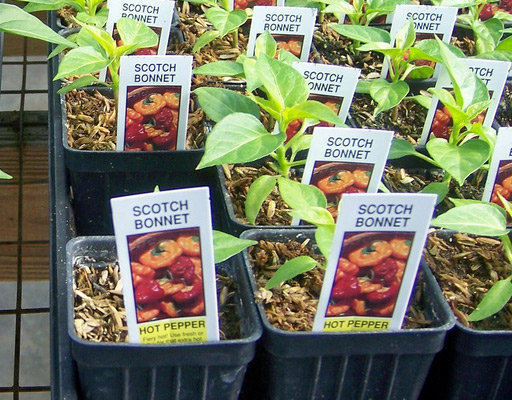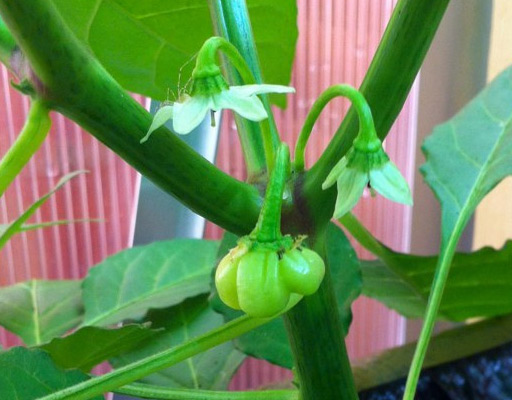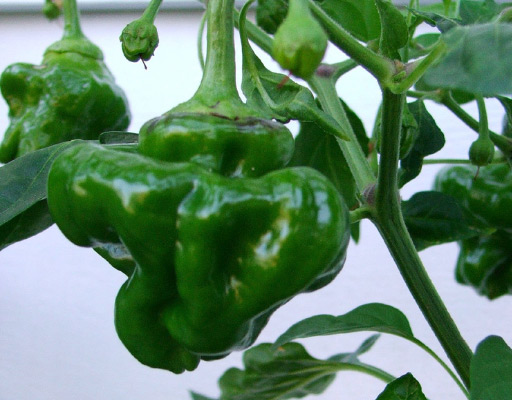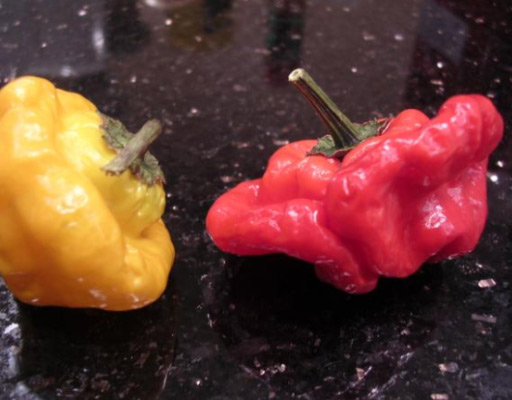Hot Peppers: The Scotch Bonnet

Seedling 
Flower 
Unripened 
Ripe (2 Varieties)
Often confused with the habanero, this Bahama mamma is among the hottest peppers in the world. Commonly used in hot sauces, the scotch bonnet is a favorite worldwide. While used in sauces that pack a powerful punch of spice, it bodes a unique hint of sweetness. Scotch bonnet sauces are incredibly popular, however the peppers themselves may be difficult to find unless you shop at a grocery store that has a specialty Caribbean section, or order them online.
Popular in Caribbean Cuisine
This pepper is mainly found in the Caribbean islands, as well as Guyana, West Africa, and the Maldives. Although this pepper has been used for flavoring a variety of culinary dishes around the globe, it is most popular in jerk and other Caribbean cuisine. This is due to its flavor combination of spicy and sweet. Many say it tastes much like a tomato with notes of cherry and apple. When preparing this hot pepper, one may cut out the flesh surrounding the seeds to reduce some of the spice.
Scotch Bonnet Shape and Names
The scotch bonnet is a medium sized pepper famous for its shape (synonymous with its name), a scotch bonnet. While it sounds innocent and bodes flavors of sweetness, it ranks 100,000 &endash; 350,000 on the Scoville scale. There is a variety that is mostly sweet, and that is called the Cachucha (aka the Ajicito).
The scotch bonnet has many names. Some include Boabs Bonnet, Bonney pepper, Caribbean red pepper, and Scotty Bons. It has even been called the Bahama Mama, Jamaican Hot, Martinique pepper, and the Bahamian. Whenever one asks for a hot pepper in the Caribbean, they will typically receive a scotch bonnet. This isn’t the hottest pepper in the world, however; there are at least two or three varieties of spicier peppers.
Varieties and Colors
Scotch bonnets come in a variety of colors and strains. Each variety has a different flavor and heat, dependent upon the soil; varying extensively by location.
Some of these different varieties include:- Tobago (or Faria)
- Grenada
- Scotch Bonnet (or Bahama Mamma)
- Burkina Yellow
- Chocolate
- Pink
- Red
- Sweet (Cachucha)
- Yellow
- Tobago Orange
- Tobago Sweet
- True Jamaican
Interesting Facts
Capsaicin is the chemical compound responsible for the spiciness within hot peppers. Since there is such a high level of capsaicin in scotch bonnets, they have become sought after by the pharmaceutical industry, as it is becoming popular in the treatment of arthritis. Capsaicin is also the key ingredient used in mace.
Growing the Scotch Bonnet
This pepper grows well in sub-tropic and tropical climates. In tropical climates it is able to grow all year round. When growing this plant in sub-tropic regions, it may be highly vulnerable to frost. This is in regions such as northern Florida. When growing this plant in a sub-tropical area, it is best to do so between the months of April through November.
Recently Added Hot Sauces that Use Scotch Bonnets
- Roofeeo Landis - Jah Mama Sauce
- Encona - Original Hot Pepper Sauce
- High River Sauces - Cheeba Gold
- Men Pa'w - La Bomba
- Baron - Blazing Hot Sauce
- Grace - Caribbean Style Hot Pepper Sauce
- Bobby's Island Spice - Ruff and Irie
- Hell's Kitchen Hot Sauce - Rockin' Rasta
*Note that many hot sauces do not specify the type of pepper used on their list of ingredients, and instead use a general phrase like “chile pepper”, so a number of sauces on our hot sauce list may not be included.
Sources and Attribution:
- Photo: Baby Scotch Bonnet Pods, by Jamie Curle (BY-NC-SA 2.0) via Flickr
- Photo: Plump Scotch Bonnets, by Steph L (cpt_obvious) (BY-NC-ND 2.0) via Flickr
- Photo: Anchos and Scotch Bonnets, by k8 (k8s) (BY-NC-SA 2.0) via Flickr
